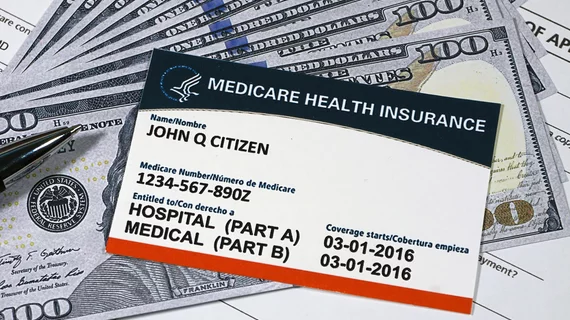Radiology Business Management Association offers 5 ways for Congress to fix broken Medicare system
The Radiology Business Management Association is suggesting five ways for Congress to potentially fix the broken Medicare payment system.
RBMA submitted its comments on Friday in response to a white paper released by the Senate in May. The 30-page document offered potential policy solutions—creating more sustainable payment updates, incentivizing physicians to provide care at lower costs, and rethinking how Medicare measures quality.
“RBMA is encouraged by the Senate Finance Committee’s important step towards meaningful Medicare physician payment reform,” Executive Director Bob Still wrote June 14. “It is crucial to implement an annual payment update that keeps pace with inflation and to modernize the outdated Medicare budget neutrality policies. These issues have resulted in significant cuts to radiology services, increased provider consolidation, and jeopardized the quality of care and access for Medicare patients…,” he added.
The association, which represents over 2,200 radiology business leaders working across 80 practices in all 50 states, is suggesting several potential fixes for the Medicare system:
1. Adjust budget neutrality requirements: Revising such rules could ensure that year-end cuts do not result in “disproportionately” impacting essential services such as radiology. Congress could do so by introducing higher thresholds for budget neutrality adjustments or excluding certain “high impact” diagnostic services from these calculations, providing “sustainability and certainty” for the specialty.
2. Implement inflationary updates: CMS has decided to postpone the incorporation of inflation-based payment updates to allow the American Medical Association to conduct a survey on practices expenses. However, RBMA believes the feds should offer a provisional pay update tied to the Medicare Economic Index, as it may take a while before the survey results surface.
“Aligning [physician fee schedule] updates, even provisional, with inflation rates, similar to other Medicare payment systems, would help ensure that reimbursement rates keep pace with the rising costs of delivering high-quality radiology care,” Still wrote. “This adjustment would support the financial viability of radiology practices and ensure continued patient access to critical imaging services.”
3. Conversion factor adjustments: Over the course of years, new or revalued CPT codes have resulted in specialties receiving “significant” increases in reimbursement for services. Meanwhile, others with a high volume of procedures such as radiology have experienced corresponding pay decreases. Creating greater thresholds or excluding certain services from these calculations “could provide much needed relief.”
“We understand the importance of ensuring adequate reimbursement for primary/preventive care services, but doing so at the expense of specialty services, including especially radiology, is unwise given the role that diagnostic imaging and interventional radiology play in early diagnosis and lower-cost treatment options,” Still wrote.
4. Promote value-based care: RBMA believes the feds should encourage the adoption of new value-based care models tailored to radiology, helping the specialty shift away from volume-focused operations. The association already has been working on its own Advanced Alternative Payment Model that would measure practices’ Medicare spending up against others in the industry. New quality metrics, Still noted, could focus on health equity or the use of clinical decision support tools.
5. Reduce barriers to breast imaging: The Affordable Care Act has required the delivery of regular screening mammography without out-of-pocket costs. However, the same provisions do not apply to supplemental exams such as ultrasound or MRI of the breast. The Find it Early Act, proposed last year, would require all payers to cover any follow-up breast exams, without any patient out-of-pocket costs. It would follow legislative efforts across 20-plus states to improve coverage for breast imaging.
“The RBMA strongly urges the Senate Finance Committee to consider these recommendations, which are crucial in mitigating the adverse effects of current policies on radiology services,” Still concluded. “By addressing the challenges posed by budget neutrality and the lack of inflationary updates, we can ensure that radiologists continue to provide high-quality, accessible, and affordable care to Medicare beneficiaries.”
MedPAC’s latest report
RBMA’s letter comes after the Medicare Payment Advisory Commission released its latest report to Congress on June 13. While Medicare beneficiaries’ access to radiologists and other physicians appears adequate, a flat payment rate proposed in 2025 does little to counter soaring expenses. Payments are slated to increase by 0.75% for certain qualifying clinicians and 0.25% for everyone else. At the same time, providers’ input costs are expected to increase by an average of 2.3% per year through 2033.
“This larger gap could create incentives for clinicians to reduce the number of Medicare beneficiaries they treat or stop participating in Medicare entirely,” the report noted.
MedPAC is suggesting two possible pathways to improve physician payments under the fee schedule. One would require updating the practice expense portion of fee schedule payment rates by the hospital market basket inflation index. But this approach would lead to specialists such as interventional radiologists and radiation oncologists receiving larger updates than primary care and other docs. A second approach would call for updating total fee schedule payment rates based on the Medicare Economic Index, minus a percentage point.
The American Medical Association responded to the report on June 13, commending MedPAC for at least recognizing the unsustainable nature of the Medicare program.
“However, the AMA remains concerned that an update less than the full inflation rate, as is the case with both approaches under MedPAC’s consideration, would force physicians to make difficult choices about how to keep the lights on and care for America’s seniors and persons with disabilities,” AMA President Bruce A. Scott, MD, said in a statement. “This would be even more problematic following years of declining payment rates and rising inflation.

